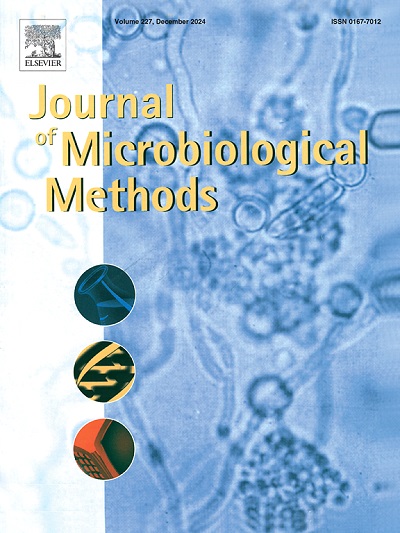Evaluation of protein extraction protocols for MALDI-TOF Biotyper analysis of mycobacteria
IF 1.9
4区 生物学
Q4 BIOCHEMICAL RESEARCH METHODS
引用次数: 0
Abstract
Infections caused by Mycobacterium tuberculosis and nontuberculous mycobacteria represent a significant global threat and medical concern. Therefore, accurate and reliable methods must be employed to identify mycobacteria rapidly. Matrix-assisted laser desorption/ionization time-of-flight mass spectrometry (MALDI-TOF MS) is a technique that compares the cellular protein profiles of unknown isolates with reference mass spectra in a database to identify microorganisms. However, the thick and waxy lipid layer, which is rich in mycolic acids and is present in mycobacterial cells, makes protein extraction challenging. To identify the optimal protocol for correctly identifying bacilli using MALDI-TOF mass spectrometry, this study compared four different cellular protein extraction methods. Four strains of M. bovis BCG were selected as representatives of slow-growing mycobacteria, while three strains of fast-growing mycobacteria were also included: M. peregrinum, M. smegmatis, and M. farcinogenes. The extraction method that proved most effective was the extraction of inactivated cells with chloroform and methanol, which partially delipidates the cells. These cells were then extracted with formic acid, as is standard practice for protein extraction. The advantage of this method is that it allows the parallel analysis of cellular lipids and proteins from a single sample. It is therefore important to optimize mycobacterial protein extraction for MALDI-TOF MS analysis in clinical microbiology laboratories.
评估用于分枝杆菌 MALDI-TOF Biotyper 分析的蛋白质提取方案。
结核分枝杆菌和非结核分枝杆菌引起的感染是一个重大的全球威胁和医学问题。因此,必须采用准确可靠的方法来快速鉴定分枝杆菌。基质辅助激光解吸电离飞行时间质谱法(MALDI-TOF MS)是一种将未知分离物的细胞蛋白质图谱与数据库中的参考质谱进行比较以鉴定微生物的技术。然而,分枝杆菌细胞中富含霉酚酸的厚蜡质脂质层使得蛋白质提取具有挑战性。为了确定使用 MALDI-TOF 质谱正确鉴定杆菌的最佳方案,本研究比较了四种不同的细胞蛋白质提取方法。研究选取了四株牛型卡介苗作为慢速生长分枝杆菌的代表,同时还选取了三株快速生长分枝杆菌:M. peregrinum、M. smegmatis 和 M. farcinogenes。事实证明,最有效的提取方法是用氯仿和甲醇提取灭活细胞,这种方法可使细胞部分脱脂。然后用甲酸提取这些细胞,这是提取蛋白质的标准做法。这种方法的优点是可以同时分析单个样本中的细胞脂质和蛋白质。因此,在临床微生物实验室进行 MALDI-TOF MS 分析时优化分枝杆菌蛋白质提取非常重要。
本文章由计算机程序翻译,如有差异,请以英文原文为准。
求助全文
约1分钟内获得全文
求助全文
来源期刊

Journal of microbiological methods
生物-生化研究方法
CiteScore
4.30
自引率
4.50%
发文量
151
审稿时长
29 days
期刊介绍:
The Journal of Microbiological Methods publishes scholarly and original articles, notes and review articles. These articles must include novel and/or state-of-the-art methods, or significant improvements to existing methods. Novel and innovative applications of current methods that are validated and useful will also be published. JMM strives for scholarship, innovation and excellence. This demands scientific rigour, the best available methods and technologies, correctly replicated experiments/tests, the inclusion of proper controls, calibrations, and the correct statistical analysis. The presentation of the data must support the interpretation of the method/approach.
All aspects of microbiology are covered, except virology. These include agricultural microbiology, applied and environmental microbiology, bioassays, bioinformatics, biotechnology, biochemical microbiology, clinical microbiology, diagnostics, food monitoring and quality control microbiology, microbial genetics and genomics, geomicrobiology, microbiome methods regardless of habitat, high through-put sequencing methods and analysis, microbial pathogenesis and host responses, metabolomics, metagenomics, metaproteomics, microbial ecology and diversity, microbial physiology, microbial ultra-structure, microscopic and imaging methods, molecular microbiology, mycology, novel mathematical microbiology and modelling, parasitology, plant-microbe interactions, protein markers/profiles, proteomics, pyrosequencing, public health microbiology, radioisotopes applied to microbiology, robotics applied to microbiological methods,rumen microbiology, microbiological methods for space missions and extreme environments, sampling methods and samplers, soil and sediment microbiology, transcriptomics, veterinary microbiology, sero-diagnostics and typing/identification.
 求助内容:
求助内容: 应助结果提醒方式:
应助结果提醒方式:


